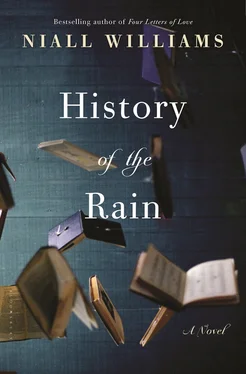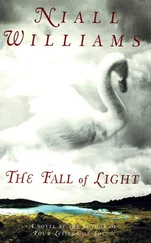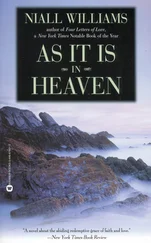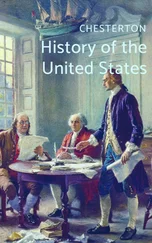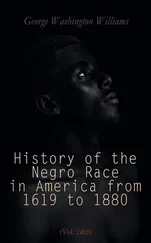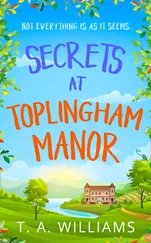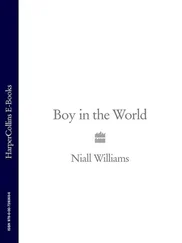Back in the time when we were all seaweed, he says, there was some seaweed already had the MacCarroll microbes or genomes or whatever and after that it was only a matter of time and creation.
Back then Ireland was down at the South Pole. So I’m thinking it would have been frozen seaweed of the sort Paddy Connolly started selling above in Quilty thinking in the Boom it would catch on like frozen yoghurt but hadn’t calculated on the power of the salt making your lips swell up like slugs in a wet June while you stood there sucking Quilty seaweed. But then the Bust came and the Japanese had the earthquake and the mini-meltdown and couldn’t eat their own and started sending delegations worldwide in search of good seaweed. A Mr Oonishi arrived in the County Clare, had a taste of frozen carrageen and went odorokuhodo yoi , which was boys o boys in Japanese, and the Connollys were back in business.
Sorry, drifting. It’s a river narrative. Once, we were all frozen seaweed.
Then, Tommy says, America split off of Africa, said See you boys later , and did the American thing, it went West.
Ireland of course did its own thing and went north. All of us were seaborne. Whatever microbes were paddling Ireland they were fierce stubborn and didn’t bother stopping at any of the sunnier climes, didn’t say Lads, what about the Canaries for a location? Didn’t say Madeira looks nice . No, they kept on, getting away from everyone, and would have kept going, Tommy says, except that Iceland had broken off above and was already in situ. The microbes were like the McInerneys who head off to Donegal each year, any number of children sardined into the back of the old Peugeot, three per seatbelt, and somewhere north of Claregalway dement their mother and father with Are we there yet . Enniscrone, County Sligo, is as far as they’ve ever made it. Tommy’s basic point: the microbes were getting restless by then. The sun had livened them up. Then the rain got them in a right stew. Suddenly we were bestirring ourselves.
Ireland came to a stop. And the seaweed-people started moving about on the land.
And some of them were MacCarrolls.
Because we were once seaweed we all long to get back there. That’s the premise. The sea is the Mother Ship. That’s the explanation for Kilkee Lahinch Fanore Ballyvaughan and all the bungalows built up and down the Atlantic coast. That’s the reason the planners couldn’t say it’ll look a bit mad and make the whole country look like we’re some kind of perverted sea-voyeurs.
So the seaweed people started moving around in the rain. Some of them, who resented their mothers, and figured out right away that the west was the rainiest part, went into the Midlands to vent their feelings and invent hurling. The MacCarrolls stayed where they were. They’d just about dried out when The Flood came, Tommy says.
‘And they all drowned?’ I asked.
‘Some of them survived,’ he said, ‘by becoming birds.’
‘That was clever.’
‘Others were swimmers.’
After The Flood withdrew things were grand for a time. Then the Partholonians came. They were already bored with sunscreen and deckchairs down in the eastern Mediterranean and arrived into Donegal on a salty gale, had a bit of Killybegs Catch, and headed south, where they met the Fomorians. The Fomorians were the misshapen one-eyed one-legged offal-eating hoppers who were peopling Offaly at the time.
Having only the one leg, they weren’t that great at fighting. The Partholonians made mincemeat and pale spongy bodhráns out of them.
By the year 520 Tommy says there were 9,046 Partholonians in Ireland. Then in one week in May a horde of midges came, brought a plague and wiped them all out.
Except for one.
Tuan MacCarrill survived by becoming a salmon.
Fact. It’s in the History of Ireland.
It’s not all that strange when you consider that story is written in the Book of the Dun Cow, which is Book Number 1 in Irish Literature and was written on the hide of Saint Ciaran’s favourite cow in Clonmacnois.
Not kidding.
Tuan survived by becoming a salmon.
Now, before you go saying those Irish , or Come off it , I will point out that though Tuan was maybe the first to use this method he was not the last. In the fat yellow paperback of David Grossman’s See Under: Love (Book 2,001, Picador, London), one of the few books in which my father inscribed his name (blue biro), Bruno Schulz escapes the Nazis by becoming a salmon. Check it out.
Anyway, years later (according to the hide of Saint Ciaran’s favourite cow), the salmon that was once Uncle Tuan was caught by a woman who ate him. It’s true. She caught him, ate him, and then, in the kind of plot twist you get when you’re writing on the hide of a Dun Cow, she gave birth to him again. He was a fine lad with distinctive red hair and salmon-coloured freckles, who had inside him the history of Ireland.
Not kidding.
The MacCarrolls were always into the stories. But first the stories were inside them.
Tuan MacCarrill had seen the Nemedians, the Partholonians, the Fir Bolgs and the Tuatha de Danann. The Tuatha de Danann were the followers of the Goddess Danu. They’d come to Ireland in long wooden boats and, tough men, burned them the moment they landed so there would be no turning back. Some of the locals looked up, saw this great boat-shaped cloud from the boat-burning and believed these fellows had sailed down from the sky.
‘The stories of them lads would fill all the libraries of the known world,’ Tommy said. But Tuan knew them all. He was the only one who could tell of the great battle against Balor of the Evil Eye, which was the first All-Ireland, but took place on the Plain of Moytura. The referee was a crow called the Morrigu. She whistled for the Throw-in and watched from a tree. When the last of the Fomorians were dead, the plain slippery with black blood and the ground underfoot spongy as figrolls in tea, the Morrigu blew up for fulltime.
Tuan MacCarrill had seen it first-hand. He was the first Embedded, the original Eyewitness Reports, a one-man Salmon News Corporation, he’d been there and seen that, getting fish-eyed Exclusives of everything from the Fomorians to the Fianna.
And so, because he’d been here since seaweed, he told the early history of Ireland to Saint Finnian of Moville, who, being a monk, had a quill handy.
It’s the way Tommy tells it.
If Ireland’s first historian had been a girl instead of a salmon-boy it would have been a different story. If the man writing it down hadn’t been a saint there’d have been other parts for women besides Goddesses, witches and swans.
So, there were seaweed people and sky people.
In time the seaweed people and the sky people found attraction in each other, and intermarried and became the Irish. That’s the short version. That’s why some of us are always longing for sky and some are of us are longing for the sea, and some, like my father, were both.
We’re a race of elsewhere people. That’s what makes us the best saints and the best poets and the best musicians and the world’s worst bankers. That’s why wherever you go you’ll see some of us — and it makes no difference if the place is soft and warm and lovely and there’s not a thing anyone could find wrong with it, there’ll always be what Jimmy the Yank calls A Hankering. It’s in the eyes. The idea of the better home. Some of us have it worse than others. My father had it running in the rivers of him.
The MacCarrolls stayed near the river. Beside the river there are two things you never forget, that the moment you look at a river that moment has already passed, and that everything is on its way somewhere else. The MacCarrolls weren’t poets. They were too stubborn for metre and rhyme schemes. They were knuckle- and knee-scrapers and collarbone breakers, they were long-hair growers. They were fisher and boatmen. They had a wild streak in them about the same width and depth as the Shannon and they had no loyalty to anyone but themselves, which was as it should be Tommy says, because Ireland then was in a complete dingdong between kings and clans and Vikings and Normans and whatnot and a lot of it was to do with O’Neills from Up North, which in Tommy’s narrative means Enough Said .
Читать дальше
